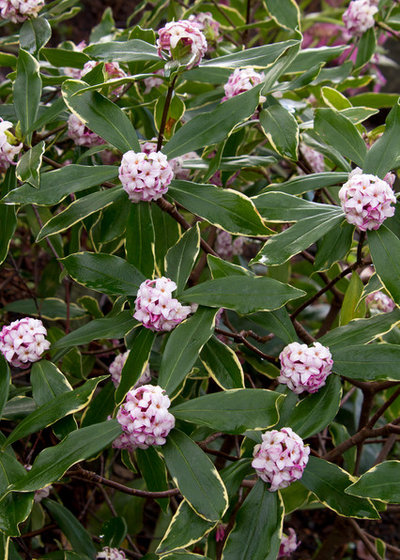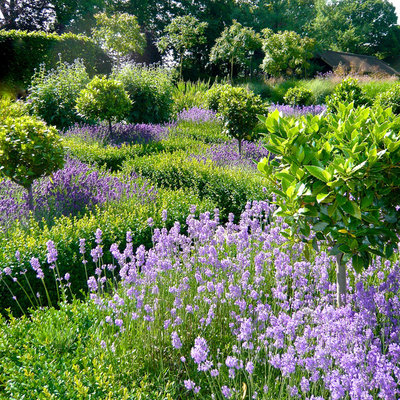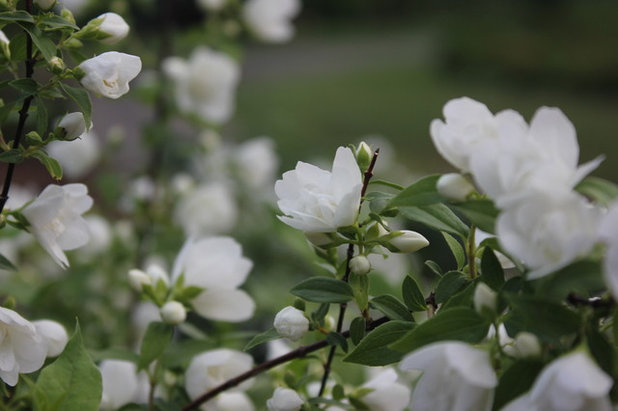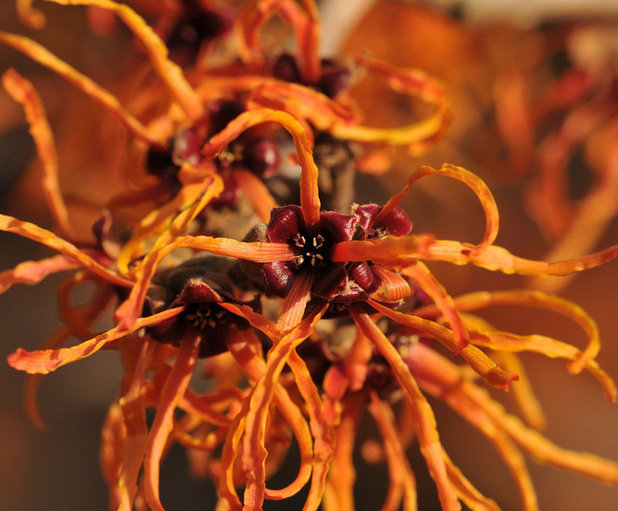Ask a garden designer: What do I need to grow plants a fragrant garden - There is something wonderful walking in a garden, being overwhelmed by a heavenly scent and not knowing where it's coming?. You hunt around to find the plant and dive into the intoxicating flowers to refresh and calm the senses. There are so many fragrant plants to choose from that will help you make it fun you can enjoy in your own garden. Here is a small selection to inspire your planting ...
Read the first part of this new series: How to Create a Haven Lush Jungle style
Read the first part of this new series: How to Create a Haven Lush Jungle style
Laara Copley-Smith Garden & Landscape design
Adorn a door with star jasmine
jasminoides Trachelospermum is a self-voluble, very fragrant, persistent woody flowering shrub in the form of white and dark green star, leaves lance-shaped. Best adult on a sunny wall, this plant is a good climber around a door, where you can enjoy its heavenly scent you brush past, walking in and out. Like most plants grown against a wall, it will need the support of a trellis or wire.
In the fall, the leaves turn red to violet, but a harsh winter or gel lead to stem the decline and foliage damage. Trachelospermum prefers fertile soil and sheltered position, just like the other popular climber and delicately scented Jasminum officinale .
Try to limit the size and be careful, like cutting the stems produces a sticky white sap that can give some people a rash.
jasminoides Trachelospermum is a self-voluble, very fragrant, persistent woody flowering shrub in the form of white and dark green star, leaves lance-shaped. Best adult on a sunny wall, this plant is a good climber around a door, where you can enjoy its heavenly scent you brush past, walking in and out. Like most plants grown against a wall, it will need the support of a trellis or wire.
In the fall, the leaves turn red to violet, but a harsh winter or gel lead to stem the decline and foliage damage. Trachelospermum prefers fertile soil and sheltered position, just like the other popular climber and delicately scented Jasminum officinale .
Try to limit the size and be careful, like cutting the stems produces a sticky white sap that can give some people a rash.
Monrovia
Improving a seat with daphne
Daphne Odora must be one of the first flowering evergreen leaves of the most intensely scented shrubs that announce the joys of spring. Its branches hold little misshapen balls or clusters of very fragrant pink flowers, while the slightly more robust form, 'Aureomarginata' has oval, narrow leaves with gold.
It is slow growing and therefore not cheap to buy plant. It is also not suitable for containers, preferring a free-draining, humus-rich soil and a sheltered position. To enjoy the fragrance at its maximum, daphnes plants near the front door or garden seat.
Prune sparingly as daphnes are highly susceptible to decay and also experience disruptions, as uprooted and displaced. If misplaced branches, you can reduce or slightly cut after flowering to maintain a good habit bushy.
For deeper varieties of color, choose the dynamic Bois-Joli for the first spring flowers, or flowers later try Daphne Retusa . If your garden is shady, but you still want a daphne, you can opt for green flowers on creamy- Daphne Pontica .
Daphne Odora must be one of the first flowering evergreen leaves of the most intensely scented shrubs that announce the joys of spring. Its branches hold little misshapen balls or clusters of very fragrant pink flowers, while the slightly more robust form, 'Aureomarginata' has oval, narrow leaves with gold.
It is slow growing and therefore not cheap to buy plant. It is also not suitable for containers, preferring a free-draining, humus-rich soil and a sheltered position. To enjoy the fragrance at its maximum, daphnes plants near the front door or garden seat.
Prune sparingly as daphnes are highly susceptible to decay and also experience disruptions, as uprooted and displaced. If misplaced branches, you can reduce or slightly cut after flowering to maintain a good habit bushy.
For deeper varieties of color, choose the dynamic Bois-Joli for the first spring flowers, or flowers later try Daphne Retusa . If your garden is shady, but you still want a daphne, you can opt for green flowers on creamy- Daphne Pontica .
Joanne Alderson Design
please the bees with lavender
Lavandula is an essential ingredient of a fragrant garden, if you plan to enjoy walking along a road lined with bushes of this wonderful woody shrub, stroking her flowers, or watching bees go crazy for its nectar-rich flowers.
This Mediterranean plant is drought tolerant and therefore good for gravel gardens and even ribs. Lavender thrive in poor soil, moderately fertile and need good drainage. In heavier soils, plants need to be replaced every few years. As they do not break easily from old wood if they are not pruned after flowering in late summer, then it is to the garden center for more!
Growing lavender as a blanket, try planting on a ridge so the foundation shrubs do not get waterlogged. Space each plant around 30cm apart or, for larger specimens, 45cm apart.
Two of the most robust and popular varieties of lavender include Lavandula angustifolia 'Hidcote', which has compact, gray-green foliage and dense, dark purple flowers, and Lavandula angustifolia 'Munstead', which has dense, mid-green leaves and lavender blue flowers. He lavenders are pink and white flowers, as well as the French Stoechas and Pedunculata cultivars, which have colorful bracts that look like rabbit ears. These varieties tend to be less robust and are ideal for containers.
Learn how to grow a garden honeybee
Lavandula is an essential ingredient of a fragrant garden, if you plan to enjoy walking along a road lined with bushes of this wonderful woody shrub, stroking her flowers, or watching bees go crazy for its nectar-rich flowers.
This Mediterranean plant is drought tolerant and therefore good for gravel gardens and even ribs. Lavender thrive in poor soil, moderately fertile and need good drainage. In heavier soils, plants need to be replaced every few years. As they do not break easily from old wood if they are not pruned after flowering in late summer, then it is to the garden center for more!
Growing lavender as a blanket, try planting on a ridge so the foundation shrubs do not get waterlogged. Space each plant around 30cm apart or, for larger specimens, 45cm apart.
Two of the most robust and popular varieties of lavender include Lavandula angustifolia 'Hidcote', which has compact, gray-green foliage and dense, dark purple flowers, and Lavandula angustifolia 'Munstead', which has dense, mid-green leaves and lavender blue flowers. He lavenders are pink and white flowers, as well as the French Stoechas and Pedunculata cultivars, which have colorful bracts that look like rabbit ears. These varieties tend to be less robust and are ideal for containers.
Learn how to grow a garden honeybee
Eden Design llc
Max out midsummer scent of orange flower
Philadelphus or mock orange as it is commonly called, is to be one of the finest scents in the summer garden.
Although this is not the prettiest of deciduous shrubs during most of the year, the profusion of white blossoms that cover the woody stems is a magnet for bees and fill the garden with a soft, orange flower fragrance from June to July. Varieties include Philadelphus 'Belle Etoile', which has simple white flowers with a purple throat; 'Virginal' which has beautiful double flowers, fragrant white; and 'Aureus', which has a golden foliage will add a light touch to a black border.
Choisya Ternata is often confused with Philadelphus name, as it is commonly known by the name of Mexican orange blossom. A very fragrant shrub aromatic glossy dark green leaves, produces fragrant flowers star-shaped in full sun to partial shade. It is fully hardy and like a fertile, well-drained soil.
Philadelphus or mock orange as it is commonly called, is to be one of the finest scents in the summer garden.
Although this is not the prettiest of deciduous shrubs during most of the year, the profusion of white blossoms that cover the woody stems is a magnet for bees and fill the garden with a soft, orange flower fragrance from June to July. Varieties include Philadelphus 'Belle Etoile', which has simple white flowers with a purple throat; 'Virginal' which has beautiful double flowers, fragrant white; and 'Aureus', which has a golden foliage will add a light touch to a black border.
Choisya Ternata is often confused with Philadelphus name, as it is commonly known by the name of Mexican orange blossom. A very fragrant shrub aromatic glossy dark green leaves, produces fragrant flowers star-shaped in full sun to partial shade. It is fully hardy and like a fertile, well-drained soil.
Steven N. Severinghaus
Wake conservatory with witch hazel
Hamamelis is commonly known as witch hazel and can be grown as a shrub or tree, making it a good choice for a small garden. During the dark days of January, the garden may seem quite stiff, but the winter arching flowers of Hamamelis are heady with their scent and color from pale yellow through orange fire heavenly and deep purple glow like embers in the garden.
This is a plant that needs to be carefully and cut the branches and bring them in the house will also fill the house with the scent and the winter sun.
Hamemalis prefer acidic soil, and are slow growing and therefore expensive. They do well in partial shade, so are ideal in a wood edge. My favorite is Hamamelis x intermedia 'Jelena' with its coppery orange flowers.
Another shrub winter flowering deciduous like you can cut and bring inside for winter arrangements is Chimonanthus Praecox or Wintersweet. The dried flowers of the mild winter can be used in the same way you use lavender to scent linen.
Hamamelis is commonly known as witch hazel and can be grown as a shrub or tree, making it a good choice for a small garden. During the dark days of January, the garden may seem quite stiff, but the winter arching flowers of Hamamelis are heady with their scent and color from pale yellow through orange fire heavenly and deep purple glow like embers in the garden.
This is a plant that needs to be carefully and cut the branches and bring them in the house will also fill the house with the scent and the winter sun.
Hamemalis prefer acidic soil, and are slow growing and therefore expensive. They do well in partial shade, so are ideal in a wood edge. My favorite is Hamamelis x intermedia 'Jelena' with its coppery orange flowers.
Another shrub winter flowering deciduous like you can cut and bring inside for winter arrangements is Chimonanthus Praecox or Wintersweet. The dried flowers of the mild winter can be used in the same way you use lavender to scent linen.
Joanne Alderson Design
classical English garden style channel with peas
Lathyrus odoratus , the last part of its name (odoratus is Latin for scented or flavored) are our plants most fragrant annual flowers. You may know them better peas. They are easily grown from seed, directly into the ground in March or April, or sown in the greenhouse and transplanting seedlings.
Sweet Pea seem better scrambling a wigwam made from pea or hazelnut sticks, or against a potting or a wooden fence hangar. More you cut the flowers before they produce pods, the more flowers you will have.
For the best flavor, choose varieties such as 'Matucana', who descended from original wild sweet peas and wonderful smells; 'Albutt Blue', which has subtle bluish purple flowers and a fantastic fragrance; or "Karen Louise," which is not only good for the vase, with its strong stems, but also has a strong fragrance, with pale lavender wreaths. Perhaps best of all for perfume, however, is the aptly named 'High Scent', which has delicate white flowers edged with purple focused on strong stems.
Explorer English garden inspiring, friendly wildlife
Lathyrus odoratus , the last part of its name (odoratus is Latin for scented or flavored) are our plants most fragrant annual flowers. You may know them better peas. They are easily grown from seed, directly into the ground in March or April, or sown in the greenhouse and transplanting seedlings.
Sweet Pea seem better scrambling a wigwam made from pea or hazelnut sticks, or against a potting or a wooden fence hangar. More you cut the flowers before they produce pods, the more flowers you will have.
For the best flavor, choose varieties such as 'Matucana', who descended from original wild sweet peas and wonderful smells; 'Albutt Blue', which has subtle bluish purple flowers and a fantastic fragrance; or "Karen Louise," which is not only good for the vase, with its strong stems, but also has a strong fragrance, with pale lavender wreaths. Perhaps best of all for perfume, however, is the aptly named 'High Scent', which has delicate white flowers edged with purple focused on strong stems.
Explorer English garden inspiring, friendly wildlife
Claudia De Yong Garden design
Scent two seasons with soft box
box sweet, or Sarcococca Confusa is becoming more popular with designers planning seasonal planting gardens.
This evergreen shrub suckering (seen here without flowers) is best planted as a large specimen in a border, as a low hedge, or in groups of three, five or more, and placed somewhere you can enjoy the smell. This very obliging plant produces long stamens small tubular leaves and white flowers, very fragrant in winter and spring, followed by red, purple or black fruit. It tolerates shade and prefers well-drained, moist soil.
Sarcococca var ruscifolia. Chinensis , a smaller variety that Confusa , is often used by arrangers of flowers, such as rods last for a couple of weeks in water. In the narrow graceful leaves, try Sarcococca Hookeriana var. Digyna - for purple stems there is an aptly named cultivar 'Purple Stem'
. box sweet, or Sarcococca Confusa is becoming more popular with designers planning seasonal planting gardens.
This evergreen shrub suckering (seen here without flowers) is best planted as a large specimen in a border, as a low hedge, or in groups of three, five or more, and placed somewhere you can enjoy the smell. This very obliging plant produces long stamens small tubular leaves and white flowers, very fragrant in winter and spring, followed by red, purple or black fruit. It tolerates shade and prefers well-drained, moist soil.
Sarcococca var ruscifolia. Chinensis , a smaller variety that Confusa , is often used by arrangers of flowers, such as rods last for a couple of weeks in water. In the narrow graceful leaves, try Sarcococca Hookeriana var. Digyna - for purple stems there is an aptly named cultivar 'Purple Stem'
Claudia De Yong Garden Design
Perfume your outside with wisteria
Wisteria can not fail to impress with its long tail and heavenly scented flowers in shades of blue, purple, pink and white.
Wisteria is a deciduous, twining climber who prefers a sunny position and can be formed as a standalone tree or pergola or wall of a house. Plants can take three to four years to produce their first flowers, then make sure that when you buy a plant was grown from a cutting or grafting, rather than from seed, as these less reliable flowers . ( You can tell if the plant was grafted looking down the shaft and see if there is a visible bulge the graft near the base of the stem.)
The most widely planted variety is Wisteria sinensis , which has purple-lilac flowers. The flowers of the variety "Formosa" are more purple while 'Amethyst' has clusters of very fragrant flowers blue-violet red-red.
To ensure that your wisteria flowers every year, prune the twining stems twice a year, once in the summer around July or August - to ensure that you remove the whippy green shoots of growth in the current year to five or six leaves - and again in January or February, when you have to cut the same growth back to two or three buds.
Wisteria can not fail to impress with its long tail and heavenly scented flowers in shades of blue, purple, pink and white.
Wisteria is a deciduous, twining climber who prefers a sunny position and can be formed as a standalone tree or pergola or wall of a house. Plants can take three to four years to produce their first flowers, then make sure that when you buy a plant was grown from a cutting or grafting, rather than from seed, as these less reliable flowers . ( You can tell if the plant was grafted looking down the shaft and see if there is a visible bulge the graft near the base of the stem.)
The most widely planted variety is Wisteria sinensis , which has purple-lilac flowers. The flowers of the variety "Formosa" are more purple while 'Amethyst' has clusters of very fragrant flowers blue-violet red-red.
To ensure that your wisteria flowers every year, prune the twining stems twice a year, once in the summer around July or August - to ensure that you remove the whippy green shoots of growth in the current year to five or six leaves - and again in January or February, when you have to cut the same growth back to two or three buds.
Claudia De Yong Garden Design
Select a classic pink
what's better than walking in a garden and be raised in another world by the heavenly scent and blowsy flowers to our most popular garden plant, rose.
There are so many varieties of roses to choose from, it can be quite bewildering when visiting a garden center; choose from the climbers, hikers, shrubs, and ground covers terrace cultivars. Roses are deep-rooted plants that can survive in soil moisture as long as it is well drained and you include some well-rotted manure or compost when planting.
For readily available scented climber is healthy and repeat-flowering, choose "New Dawn", which cluster silver blush pink flowers and healthy, glossy foliage, or try the more forceful "Mme Alfred Carrière ', with its large,. sweetly scented, pink-tinted cream white flowers caps
For shrub roses, try 'Boscobel', which perfectly formed flowers rich salmon dressed with myrrh smell; it is repeat-flowering and disease resistant.
Alternatively wonderful, deep purple velvet pink Munstead Wood 'is ideal for pots and containers and blackberry scents, plums and blueberries.
what's better than walking in a garden and be raised in another world by the heavenly scent and blowsy flowers to our most popular garden plant, rose.
There are so many varieties of roses to choose from, it can be quite bewildering when visiting a garden center; choose from the climbers, hikers, shrubs, and ground covers terrace cultivars. Roses are deep-rooted plants that can survive in soil moisture as long as it is well drained and you include some well-rotted manure or compost when planting.
For readily available scented climber is healthy and repeat-flowering, choose "New Dawn", which cluster silver blush pink flowers and healthy, glossy foliage, or try the more forceful "Mme Alfred Carrière ', with its large,. sweetly scented, pink-tinted cream white flowers caps
For shrub roses, try 'Boscobel', which perfectly formed flowers rich salmon dressed with myrrh smell; it is repeat-flowering and disease resistant.
Alternatively wonderful, deep purple velvet pink Munstead Wood 'is ideal for pots and containers and blackberry scents, plums and blueberries.
Claudia De Yong Garden Design
Setting an entry with viburnum
Some viburnum look rather modest, but it is one of the easiest very fragrant shrubs to grow.
One of the most fragrant varieties is Viburnum x burkwoodii , which dished a fragrant clusters of white flowers and glossy green leaves, and flowers throughout the month April. Viburnum x bodnantense 'Dawn' has fragrant pink flowers from late autumn to spring and can grow up to 10ft. Viburnum really do not need much pruning; they are mainly tailored to the form, and older shrubs can be rejuvenated if cut to the ground, leaving the strong shoots up.
Viburnum Tinus is often grown as a standard and even if it does not smell as fragrant as other varieties, it often flower. You could choose instead of the bay or other evergreen shrubs standard on each side of a door.
Tell us ...
What is your all-time favorite garden scent? Share your tips in the comments below.
Some viburnum look rather modest, but it is one of the easiest very fragrant shrubs to grow.
One of the most fragrant varieties is Viburnum x burkwoodii , which dished a fragrant clusters of white flowers and glossy green leaves, and flowers throughout the month April. Viburnum x bodnantense 'Dawn' has fragrant pink flowers from late autumn to spring and can grow up to 10ft. Viburnum really do not need much pruning; they are mainly tailored to the form, and older shrubs can be rejuvenated if cut to the ground, leaving the strong shoots up.
Viburnum Tinus is often grown as a standard and even if it does not smell as fragrant as other varieties, it often flower. You could choose instead of the bay or other evergreen shrubs standard on each side of a door.
Tell us ...
What is your all-time favorite garden scent? Share your tips in the comments below.









